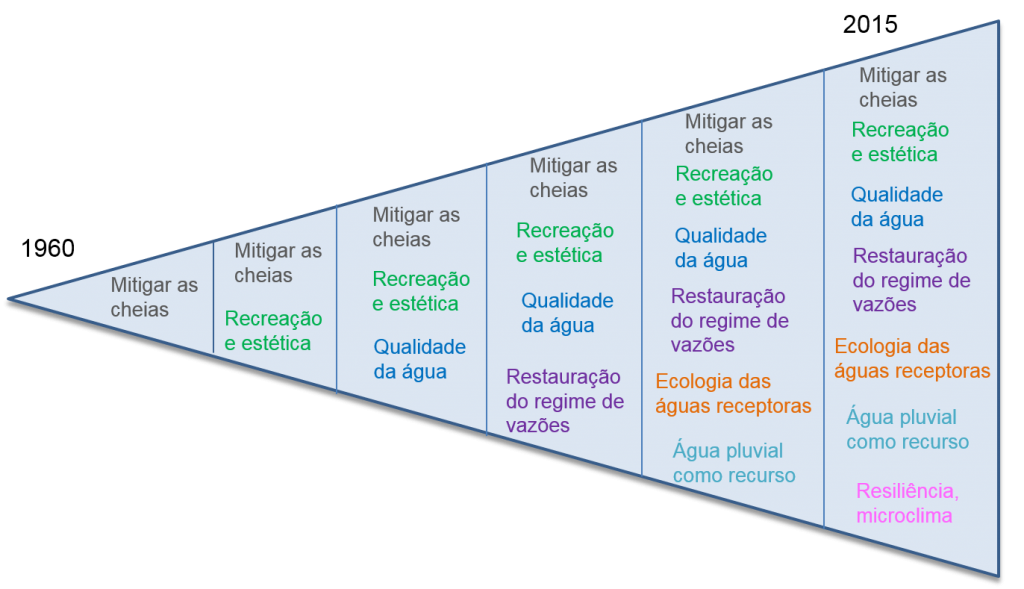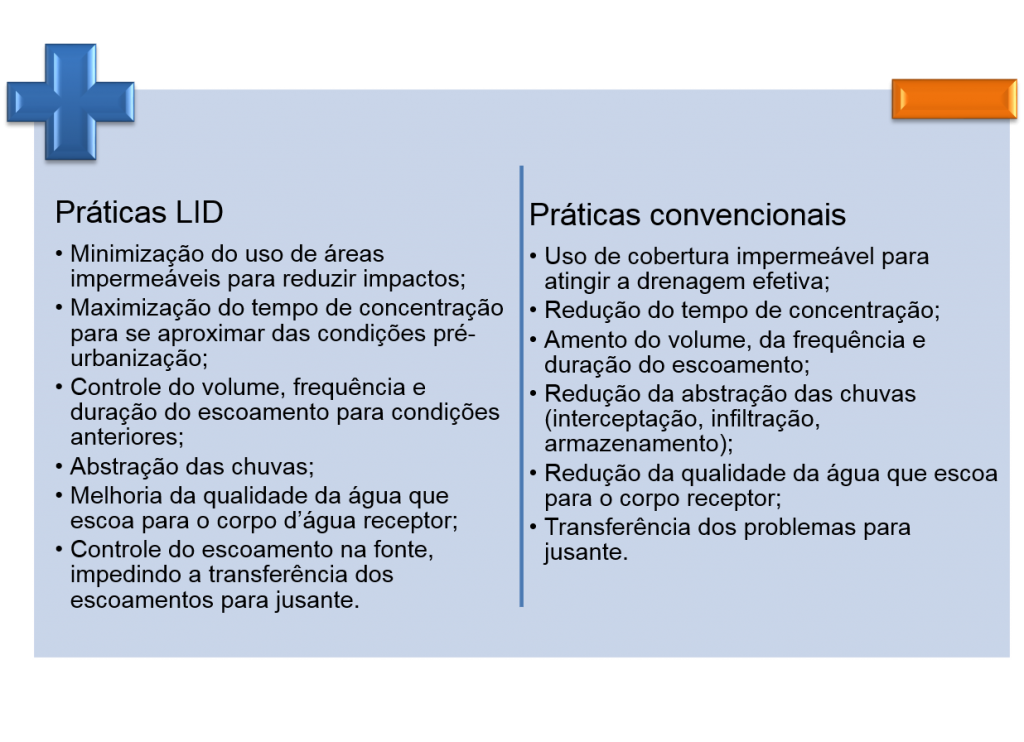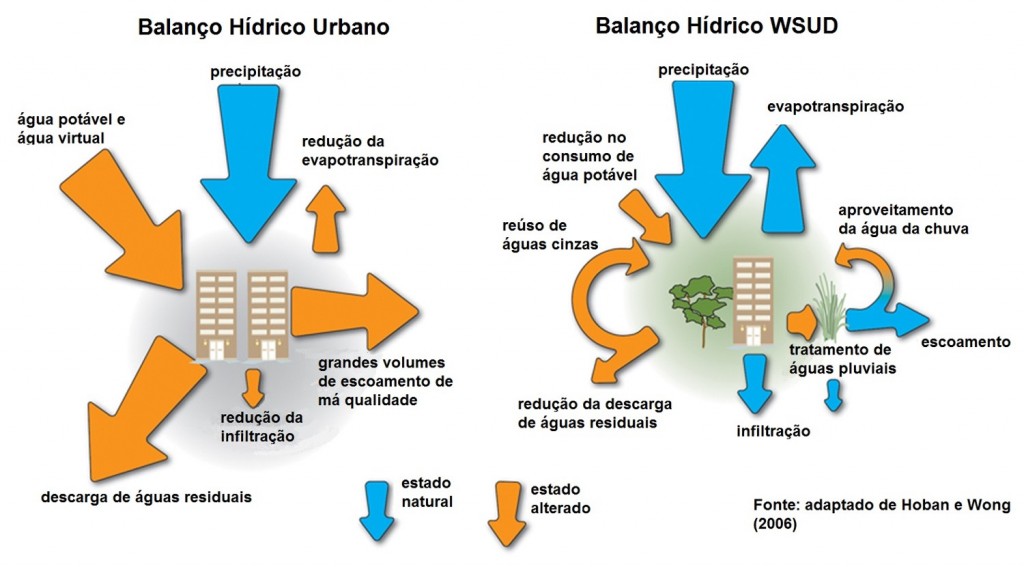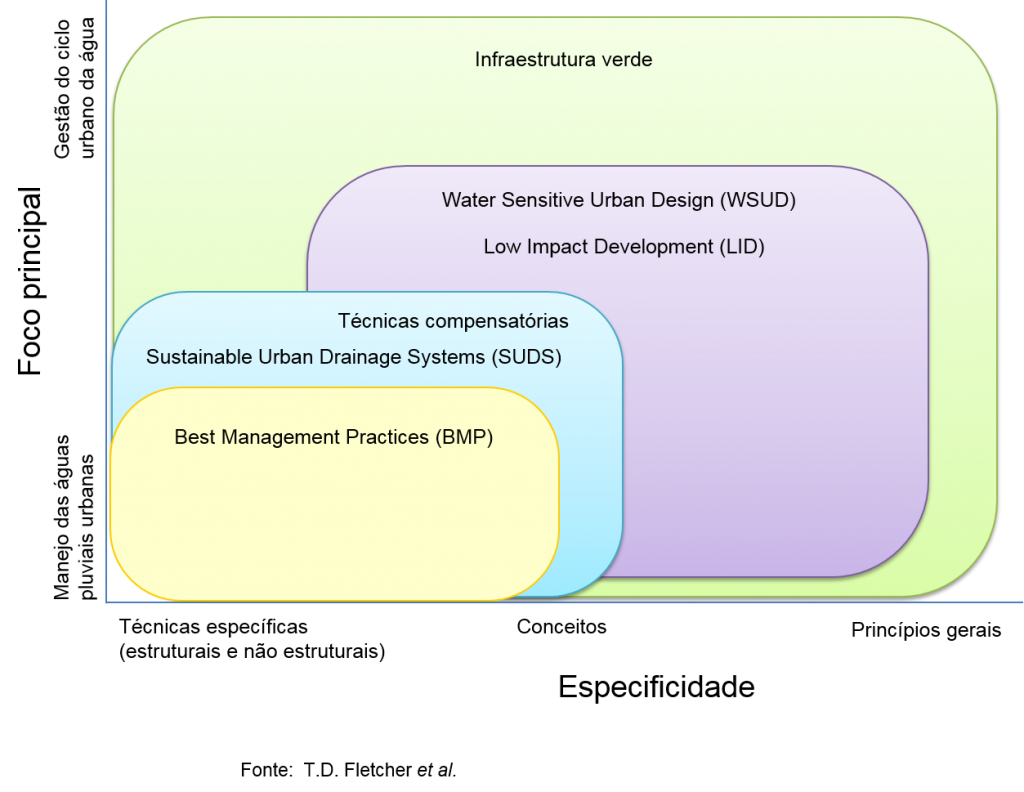This page has very good graphics on LID and SuDS
http://www.aquafluxus.com.br/bmp-lid-suds-wsud-e-infraestrutura-verde-praticas-que-revolucionam-a-drenagem-urbana/

A urbanização provoca modificações no ciclo hidrológico, alterando suas parcelas e o balanço hídrico da bacia hidrográfica. A urbanização desordenada associada à falta de manejo e ao uso inadequado do solo provoca a redução da capacidade de armazenamento natural dos deflúvios, modificando os padrões de drenagem. A solução tradicionalmente adotada para a drenagem urbana visa o aumento da velocidade dos escoamentos com obras de canalização dos rios, o que acaba transferindo o problema para jusante e implica em continuadas intervenções localizadas após eventos de inundação. No entanto, uma abordagem mais atual, a chamada Drenagem Urbana Sustentável, busca soluções que proporcionam aretenção artificial das águas pluviais, a fim de compensar as perdas na retenção natural. A figura abaixo mostra a evolução da gestão da drenagem urbana ao longo dos anos, que no princípio tinha como objetivo apenas mitigar a ocorrência de cheias e que hoje objetiva também a melhoria da qualidade das águas drenadas, a restauração do regime de vazões, o aproveitamento das águas da chuva, entre outros.

A drenagem sustentável tem como focos principais:
A seguir são apresentadas, resumidamente, as principais abordagens e as características de cada uma.
Melhores práticas de gestão – BMP (Best Management Practices)
É um conjunto planejado de ações implementadas na bacia, com o objetivo de atenuar os impactos da urbanização, buscando reduzir a quantidade de água lançada no corpo receptor através da infiltração, e também melhorias na qualidade dessas águas. Exemplos típicos de BMPs incluem dispositivos de detenção ou retenção, instalações de infiltração e wetlands. Um exemplo de projeto com o uso destas técnicas foi apresentado no post EXEMPLO DE BMP PARA CONTROLE DE INUNDAÇÕES – LOS ANGELES, CA. As BMPs atuam tanto com medidas estruturais quanto com medidas não estruturais.

Desenvolvimento de Baixo Impacto – LID (Low Impact Development)
Considera o problema de forma integrada, tentando resgatar as características naturais do ciclo hidrológico, enquanto agrega valor à própria cidade. Projetos com uso de LIDs são elaborados de forma a se criar uma “paisagem multifuncional” capaz de incorporar características de projeto que buscam simular as funções de infiltração e armazenamento da bacia pré-urbanizada. Essa técnica foi bem explicada no post CRIANDO CIDADES SUSTENTÁVEIS. Abaixo são apresentadas as principais diferenças entre as práticas LID e as práticas convencionais.

Técnicas compensatórias
 Buscam favorecer a retenção e infiltração das águas precipitadas, visando o rearranjo temporal das vazões e a diminuição do volume escoado, reduzindo a probabilidade de inundações e aumentando a qualidade das águas pluviais. Tem como princípio inicial: manter as mesmas vazões das condições de pré-urbanização, buscando compensar os impactos da urbanização por meio da redução do volume de escoamento superficial, das vazões de pico e consequente redução da vulnerabilidade das áreas urbanas a inundações. O post O IMPACTO DAS TÉCNICAS COMPENSATÓRIAS apresentou um projeto acadêmico que testou o uso dessas técnicas.
Buscam favorecer a retenção e infiltração das águas precipitadas, visando o rearranjo temporal das vazões e a diminuição do volume escoado, reduzindo a probabilidade de inundações e aumentando a qualidade das águas pluviais. Tem como princípio inicial: manter as mesmas vazões das condições de pré-urbanização, buscando compensar os impactos da urbanização por meio da redução do volume de escoamento superficial, das vazões de pico e consequente redução da vulnerabilidade das áreas urbanas a inundações. O post O IMPACTO DAS TÉCNICAS COMPENSATÓRIAS apresentou um projeto acadêmico que testou o uso dessas técnicas.
Para saber mais sobre as técnicas compensatórias leia o post 5 MANEIRAS SIMPLES DE MELHORAR O CONTROLE DAS ENCHENTES URBANAS.
Sustainable urban drainage systems – SUDS
Desenvolvidos para melhorar o desenho urbano e a gestão de riscos ambientais, assim como promover a melhoria do ambiente construído, buscando reduzir os escoamentos superficiais através de estruturas de controle da água pluvial em pequenas unidades. Inclui medidas não estruturais como layouts alternativos de estradas e prédios para minimizar a impermeabilização dos solo e maximizar seu uso.
Water sensitive urban design (WSUD)
Como Osvaldo escreveu no post MANEJO DE ÁGUAS PLUVIAIS: QUEM ESTÁ INOVANDO NA ÁREA? , esse conceito “implica em inverter a lógica de adaptação dos sistemas hídricos às necessidades da cidade para uma abordagem de adaptação da cidade ao ciclo hidrológico, mitigando ao máximo os impactos da urbanização e aproveitando todo o potencial da água na paisagem e na vida urbana.”
Os princípios básicos são:

Infraestrutura verde – GI (Green Infrastructure)
A infraestrutura verde coloca a conservação da biodiversidade num contexto político mais vasto, no qual os objetivos primários da conservação da natureza são alcançados em estreita harmonia com outros objetivos de uso do solo relacionados, por exemplo, com a agricultura, a silvicultura, o lazer e recreio e a adaptação às alterações climáticas. Intervenções urbanas que utilizam práticas da Infraestrutura Verde podem proporcionar maior infiltração da água e sua filtragem, bem como evapotranspiração e evaporação, reduzindo os efeitos de ilhas de calor e promovendo um melhor quadro climático na cidade. Além de atuar na gestão das águas pluviais também contribui na redução das enchentes e na melhoria da qualidade do ar. É o conceito mais amplo, dentre todos os apresentados.
O quadro abaixo, apresentado no artigo SUDS, LID, BMPs, WSUD and more – The evolution and application of terminology surrounding urban drainage, publicado no Urban Water Journal, apresenta as diferentes concepções de acordo com suas especificidades e foco principal.

Para saber mais sobre drenagem sustentável leia os posts:
DRENAGEM URBANA: CLÁSSICA X SUSTENTÁVEL
MAS QUAL É A VANTAGEM DA DRENAGEM SUSTENTÁVEL?)

A drenagem sustentável tem como focos principais:
- respeitar o funcionamento natural da bacia hidrográfica;
- minimizar os impactos da urbanização;
- melhor controle sobre os riscos de inundações;
- menor custo com readequações do sistema de drenagem (custos com “reinvestimentos”).
A seguir são apresentadas, resumidamente, as principais abordagens e as características de cada uma.
Melhores práticas de gestão – BMP (Best Management Practices)
É um conjunto planejado de ações implementadas na bacia, com o objetivo de atenuar os impactos da urbanização, buscando reduzir a quantidade de água lançada no corpo receptor através da infiltração, e também melhorias na qualidade dessas águas. Exemplos típicos de BMPs incluem dispositivos de detenção ou retenção, instalações de infiltração e wetlands. Um exemplo de projeto com o uso destas técnicas foi apresentado no post EXEMPLO DE BMP PARA CONTROLE DE INUNDAÇÕES – LOS ANGELES, CA. As BMPs atuam tanto com medidas estruturais quanto com medidas não estruturais.

Desenvolvimento de Baixo Impacto – LID (Low Impact Development)
Considera o problema de forma integrada, tentando resgatar as características naturais do ciclo hidrológico, enquanto agrega valor à própria cidade. Projetos com uso de LIDs são elaborados de forma a se criar uma “paisagem multifuncional” capaz de incorporar características de projeto que buscam simular as funções de infiltração e armazenamento da bacia pré-urbanizada. Essa técnica foi bem explicada no post CRIANDO CIDADES SUSTENTÁVEIS. Abaixo são apresentadas as principais diferenças entre as práticas LID e as práticas convencionais.

Técnicas compensatórias
 Buscam favorecer a retenção e infiltração das águas precipitadas, visando o rearranjo temporal das vazões e a diminuição do volume escoado, reduzindo a probabilidade de inundações e aumentando a qualidade das águas pluviais. Tem como princípio inicial: manter as mesmas vazões das condições de pré-urbanização, buscando compensar os impactos da urbanização por meio da redução do volume de escoamento superficial, das vazões de pico e consequente redução da vulnerabilidade das áreas urbanas a inundações. O post O IMPACTO DAS TÉCNICAS COMPENSATÓRIAS apresentou um projeto acadêmico que testou o uso dessas técnicas.
Buscam favorecer a retenção e infiltração das águas precipitadas, visando o rearranjo temporal das vazões e a diminuição do volume escoado, reduzindo a probabilidade de inundações e aumentando a qualidade das águas pluviais. Tem como princípio inicial: manter as mesmas vazões das condições de pré-urbanização, buscando compensar os impactos da urbanização por meio da redução do volume de escoamento superficial, das vazões de pico e consequente redução da vulnerabilidade das áreas urbanas a inundações. O post O IMPACTO DAS TÉCNICAS COMPENSATÓRIAS apresentou um projeto acadêmico que testou o uso dessas técnicas.Para saber mais sobre as técnicas compensatórias leia o post 5 MANEIRAS SIMPLES DE MELHORAR O CONTROLE DAS ENCHENTES URBANAS.
Sustainable urban drainage systems – SUDS
Desenvolvidos para melhorar o desenho urbano e a gestão de riscos ambientais, assim como promover a melhoria do ambiente construído, buscando reduzir os escoamentos superficiais através de estruturas de controle da água pluvial em pequenas unidades. Inclui medidas não estruturais como layouts alternativos de estradas e prédios para minimizar a impermeabilização dos solo e maximizar seu uso.
Water sensitive urban design (WSUD)
Como Osvaldo escreveu no post MANEJO DE ÁGUAS PLUVIAIS: QUEM ESTÁ INOVANDO NA ÁREA? , esse conceito “implica em inverter a lógica de adaptação dos sistemas hídricos às necessidades da cidade para uma abordagem de adaptação da cidade ao ciclo hidrológico, mitigando ao máximo os impactos da urbanização e aproveitando todo o potencial da água na paisagem e na vida urbana.”
Os princípios básicos são:
- gestão integrada de água potável, águas residuais e águas pluviais;
- integração da gestão das águas urbanas na escala individual do lote à escala regional;
- integração da gestão sustentável das águas urbanas, arquitetura e paisagismo; e
- integração das medidas estruturais e não-estruturais no manejo sustentável das águas urbanas.

Infraestrutura verde – GI (Green Infrastructure)
A infraestrutura verde coloca a conservação da biodiversidade num contexto político mais vasto, no qual os objetivos primários da conservação da natureza são alcançados em estreita harmonia com outros objetivos de uso do solo relacionados, por exemplo, com a agricultura, a silvicultura, o lazer e recreio e a adaptação às alterações climáticas. Intervenções urbanas que utilizam práticas da Infraestrutura Verde podem proporcionar maior infiltração da água e sua filtragem, bem como evapotranspiração e evaporação, reduzindo os efeitos de ilhas de calor e promovendo um melhor quadro climático na cidade. Além de atuar na gestão das águas pluviais também contribui na redução das enchentes e na melhoria da qualidade do ar. É o conceito mais amplo, dentre todos os apresentados.
O quadro abaixo, apresentado no artigo SUDS, LID, BMPs, WSUD and more – The evolution and application of terminology surrounding urban drainage, publicado no Urban Water Journal, apresenta as diferentes concepções de acordo com suas especificidades e foco principal.

Para saber mais sobre drenagem sustentável leia os posts:
DRENAGEM URBANA: CLÁSSICA X SUSTENTÁVEL
MAS QUAL É A VANTAGEM DA DRENAGEM SUSTENTÁVEL?)



